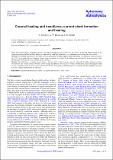Files in this item
Coronal heating and nanoflares : current sheet formation and heating
Item metadata
| dc.contributor.author | Bowness, Ruth | |
| dc.contributor.author | Hood, Alan William | |
| dc.contributor.author | Parnell, Clare Elizabeth | |
| dc.date.accessioned | 2014-01-14T12:31:04Z | |
| dc.date.available | 2014-01-14T12:31:04Z | |
| dc.date.issued | 2013-12 | |
| dc.identifier | 51723883 | |
| dc.identifier | 1c3965ff-48dc-4711-a9ff-4128333bf70f | |
| dc.identifier | 000328754500089 | |
| dc.identifier | 84890447385 | |
| dc.identifier | 000328754500089 | |
| dc.identifier.citation | Bowness , R , Hood , A W & Parnell , C E 2013 , ' Coronal heating and nanoflares : current sheet formation and heating ' , Astronomy & Astrophysics , vol. 560 , A89 . https://doi.org/10.1051/0004-6361/201116652 | en |
| dc.identifier.issn | 0004-6361 | |
| dc.identifier.other | ORCID: /0000-0003-2620-2068/work/58055155 | |
| dc.identifier.other | ORCID: /0000-0002-4090-5168/work/59698740 | |
| dc.identifier.other | ORCID: /0000-0002-5694-9069/work/73700724 | |
| dc.identifier.uri | https://hdl.handle.net/10023/4364 | |
| dc.description.abstract | Aims: Solar photospheric footpoint motions can produce strong, localised currents in the corona. A detailed understanding of the formation process and the resulting heating is important in modelling nanoflares, as a mechanism for heating the solar corona. Methods: A 3D MHD simulation is described in which an initially straight magnetic field is sheared in two directions. Grid resolutions up to 5123 were used and two boundary drivers were considered; one where the boundaries are continuously driven and one where the driving is switched off once a current layer is formed. Results: For both drivers a twisted current layer is formed. After a long time we see that, when the boundary driving has been switched off, the system relaxes towards a lower energy equilibrium. For the driver which continuously shears the magnetic field we see a repeating cycle of strong current structures forming, fragmenting and decreasing in magnitude and then building up again. Realistic coronal temperatures are obtained. | |
| dc.format.extent | 14 | |
| dc.format.extent | 4468631 | |
| dc.language.iso | eng | |
| dc.relation.ispartof | Astronomy & Astrophysics | en |
| dc.subject | Magnetohydrodynamics (MHD) | en |
| dc.subject | Magnetic reconnection | en |
| dc.subject | Corona | en |
| dc.title | Coronal heating and nanoflares : current sheet formation and heating | en |
| dc.type | Journal article | en |
| dc.contributor.sponsor | Science & Technology Facilities Council | en |
| dc.contributor.institution | University of St Andrews. Applied Mathematics | en |
| dc.contributor.institution | University of St Andrews. Gillespie Group | en |
| dc.identifier.doi | https://doi.org/10.1051/0004-6361/201116652 | |
| dc.description.status | Peer reviewed | en |
| dc.identifier.grantnumber | ST/K000950/1 | en |
This item appears in the following Collection(s)
Items in the St Andrews Research Repository are protected by copyright, with all rights reserved, unless otherwise indicated.

